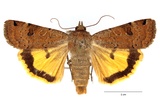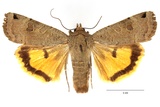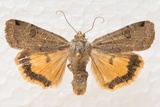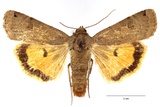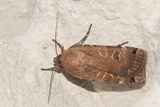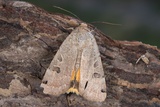Noctua orbona (Hufnagel, 1766) Species
Last modified: Nov. 20, 2025, 1:01 p.m.
A very rare and local species throughout Belgium, mainly distributed on dry sandy soils.
More observed in the Kempen, mostly as singletons, but sometimes in higher numbers.
It's a declining species everywhere in Europe.
This species is considered Endangered according to the IUCN Red List category for Flanders 2023.
Details
- Classification
- Family: Noctuidae > Subfamily: Noctuinae > Tribus: Noctuini > Genus: Noctua > Species: Noctua orbona
- Vernacular names
- Zwartpuntvolgeling (NL), Lunar Yellow Underwing (EN), La Suivante (FR), Schmalflügelige Bandeule (DE)
- Synonyms
- Noctua subsequa (Denis & Schiffermüller, 1775)
- First mention in Belgium
- De Sélys-Longchamps E. 1844. Énumération des insectes Lépidoptères de la Belgique. — Mémoires de la Société royale des Sciences de Liége 2: 1–35. On page 11 (as Triphaena orbona F.). view page
- Status
-
Native
Distribution
Caterpillar
The larva is active during the night.
Bionomics
Pupation in a small hole underground.
In the summer during extremely warm and dry periods, the adults are inactive and holding a rest period, called aestivation. They come to light and sugar.
Flight periods
The adults fly in one long generation from the end of May till the end of September.
Observed on
- Substrates:
- Herbaceous plants and Grasses
The larva feeds on grasses and a variety of herbaceous plants.
Habitat
It inhabits nutrient-poor grasslands and heathland.
